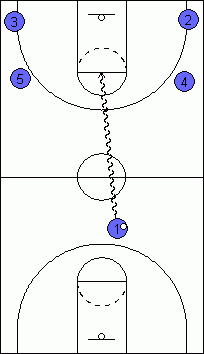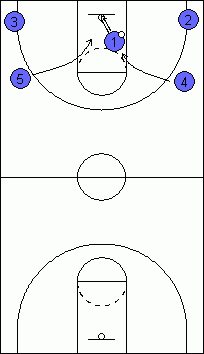3 Unorthodox Ways to Score in Transition
Not all transitions look the same. Here are a few you might not recognize.
Unorthodox Transition Method #1
The first instance is something I have used, mostly at the end of games when we had only one possession left and we needed it to win the game. I am amazed at how effective it was. First, when we gained possession, we did not call time out. We immediately went into "4 Wide."
First, when we gained possession, we did not call time out. We immediately went into "4 Wide."
It is very simple. Four players would sprint up the court, all outside the 3-point line. The first one up on each side would go to the corners and stay wide. Their job was to force the defenders to choose between guarding the basket or shading the long shot for the game. The last one up on each side would stay above the foul line and outside the 3-point line, around foul line extended. The ball handler would come down the middle of the floor with the ball. He had only one option, take a lay-up. I don't care how many players are in the lane. I don't care how many defenders he has to run over. He has to get the ball to the rim.
In the transition, invariably, at least 1 player will chase the players in the corner, leaving a driving lane for the ball handler. Half the time, the defenders in the lane will back away from the ballhandler, afraid to commit a foul. If there is contact, a large majority of the time, a foul on the defense is called. Many times the ball handler will get exactly what he wants, a lay-up.
 What make this effect, and unusual, is the 2 players that are foul line extended. Their job is to follow the ballhandler
into the lane, staying behind, and rebound. When the ball handler takes a lay-up, it's not important if it goes in. He
must get the ball on the backboard. When the defense collapses on the ball handler and he gets the ball on the rim or
backboard, the 2 rebounders expect a miss and follow with the game winning rebound. It has been very effective.
What make this effect, and unusual, is the 2 players that are foul line extended. Their job is to follow the ballhandler
into the lane, staying behind, and rebound. When the ball handler takes a lay-up, it's not important if it goes in. He
must get the ball on the backboard. When the defense collapses on the ball handler and he gets the ball on the rim or
backboard, the 2 rebounders expect a miss and follow with the game winning rebound. It has been very effective.
Unorthodox Transition Method #2
The next transition situation was one I got beaten at. We played a team that had two great ingredients, a point guard with great shooting range and a running center with great hands.We were up 2 and missed a foul shot with 7 seconds to go. The other team clears the rebound to the point guard. There were 5 seconds to go when the point guard came one step over the mid-court line when he raised up and took a jumper.
After the game, I went to the point guard, who was known for heady play and always knowing the situation, and asked him, "With 5 seconds left to play and with so much open court ahead of you, why did you shoot a jumper from 40 feet?" He told me, "It's a little thing we do. I wait until our center is on the sprint and then launch one with a high arc. All I want to do is get the ball near the rim. When he is on the sprint, we know he will rebound over anyone. I just have to leave enough time for him to shoot it after he rebounds it." Pretty smart, and good teamwork.
By the way, the play didn't work. The shot went in and we lost by 1.
Unorthodox Transition Method #3
A third unusual transition situation was run by the great coach, Paul Westhead. Before he came up with his "Chuck and Duck" break that allowed Loyola Marymount set records for offense in the 80's (they averaged over 100 points per game), he ran the "Zero" defense when he was at LaSalle. He called it the "Zero" defense because one player on his team would play zero defense.LaSalle would defend in a 3-2 zone defense. Whenever possible, the point player on the defense, would make a strong attempt to steal the ball, whether on the dribble or on the pass. If he made the steal, he was off to the races. There's nothing unusual about that. What was unusual was what happened when he didn't get the ball.
If he did not make a steal, he would continue up the floor and set up in a corner, he never came back on defense. These were the days before the shot clock in college basketball. There were times I saw him up in the corner for 2 or 3 minutes at a time. His teammates would play a 4-man defense for extended periods of time. When there was a score, LaSalle would get the ball out of bounds with a full court pass for a lay-up.
Sometimes, when a shot was in the air, the defense would sprint a man back to try to cover the "Zero" man. When that happened, Westhead would send another man up on offense and play "Double Zero" defense. They would play 3 men on defense with 2 up on the offensive end. Eventually, there was some serious up-and-down basketball play.
What do you think of these unorthodox methods? Let us know by leaving your comments, suggestions, and questions below...
Related Articles & Products
How to Develop a High Scoring Motion OffenseNorth Carolina Fast Break Offense
Phoenix Suns Fast Break Offense
|
|||||||||||||||||||



 Facebook (145k Followers)
Facebook (145k Followers) YouTube (152k Subscribers)
YouTube (152k Subscribers) Twitter (33k Followers)
Twitter (33k Followers) Q&A Forum
Q&A Forum Podcasts
Podcasts